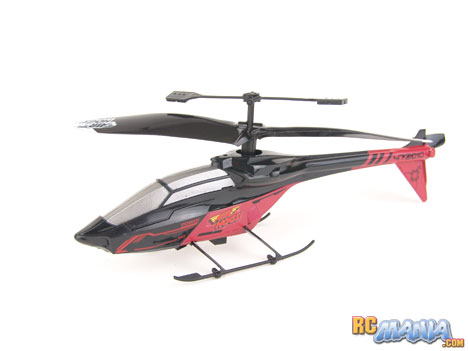Air Hogs Helix 360

Street Price: $59.99 US
Manufacturer: Spinmaster
Mfgr's recommended min. age: 12
Our recommended age range: 12 to adult
Primary use: Indoor
Top speed: n/a
Radio: n/a, infrared
Includes:
- Assembled aircraft
- Controller / charger
- Instructions
- 2x spare tail rotors
- 4x AA batteries
Initial Impressions
At first glance the Air Hogs Helix 360 looks like just another basic 2-channel heli like a regular Havoc, only a little larger. Then you look at the price tag, and notice it costs 4 times as much, and you know there must be something you're missing. Indeed, the Helix 360 doesn't have the traditional 2 channels of control, or even 3 -- it has 4! As far as I know, this is the very first toy-class 4-channel helicopter to be released by a major brand. A two channel heli can go up & down and turn, and will always fly forward slowly if it has a little weight in front. Add one channel and you gain the ability to hover in place and go forward & backward on command. With 4 channels, you get all of that plus the ability to "strafe," moving directly left or right without actually turning. When you put all of these together, you have the ability to perform any movement that a normal real-life helicopter can.
Testing
Flying the Air Hogs Helix 360 can take quite a lot of practice even if you have plenty of experience with 2- or 3-channel helis. The main thing that makes it tough is that turning is on the left stick on the controller, the same as throttle. The right stick controls forward/back motion like a 3-channel setup, but moving it left & right controls sideways strafing. In the world of advanced hobby-level RC helicopters, this is a common control layout called "mode 2," which emulates the setup of a full-sized heli. The good news is that once you start to get the hang of it, you can really go anywhere on command. The bad news is that you only get about 5 minutes at a time to learn before the battery is dead. Once you're out of juice, you're supposed to wait at least 10 minutes for the battery to cool, and then it takes up to 30 minutes for a fresh charge. Though that's fairly typical for a controller-charged aircraft, the flight times felt shorter to me, probably because there's a lot more going on and it can get quite exciting.
In the air, the Helix 360 was moderately stable. It has a built-in gyro to keep the nose pointed in one direction (once properly trimmed), but the heli still tends to wander around forward to back and side to side. There's a little delay in the controls, too, so when you try to counter a small unintended movement, you don't see much change in movement until you've actually corrected too far. It requires a lot of concentration and fine finger work to get it to hover within a three-foot cube of airspace. Actually flying around with some speed is where the Helix 360 shines. With sufficient practice, you can do some very fast maneuvers, banked turns, moving spins, and sudden reversals. The controls really reward big, fast movements once you become confident with them, and you can really tear up the air in even a pretty small room without ever crashing.
As noted in the video, one really annoying problem that 2- and 3-channel helicopters often face is getting sucked into walls. I don't know exactly why it happens, but as a heli gets close to a wall, especially if it's also anywhere near the ground or another horizontal surface like a table, desk, or bed, the wind that the heli itself creates actually pulls (or maybe pushes) the craft towards the wall, sometimes with so much force that you just can't get away. The Helix 360 experiences this same force, but, it has the control and the power to always overcome it. The worst thing is if you get really close to a wall while facing sideways, so close that you can't spin the tail around to try to power away from it. With the Helix 360's strafe control, you always have a way out.
Video
(Click a video a second time to view it larger in a new window.)
Conclusion
The Air Hogs Helix 360 features an advanced design packed into a sleek, unassuming package, and the amount of control it allows is unprecedented for a toy-class heli. When it was first released, it was $80 US, and I did not think what it added over a 3-channel heli was worth the hefty step up in price. For $80, you could get a much larger, hobby-grade 4-channel coaxial helicopter from Xheli.com with replaceable blades, a removable battery pack (so you can buy spares and run pack after pack), and a full set of trims to set it up to truly hover in one place without shifting from side to side. With the street price reduced to $59.99 in 2011, I think this is now a better deal for an Air Hogs heli fan who wants to move on to the next level of piloting and control.





